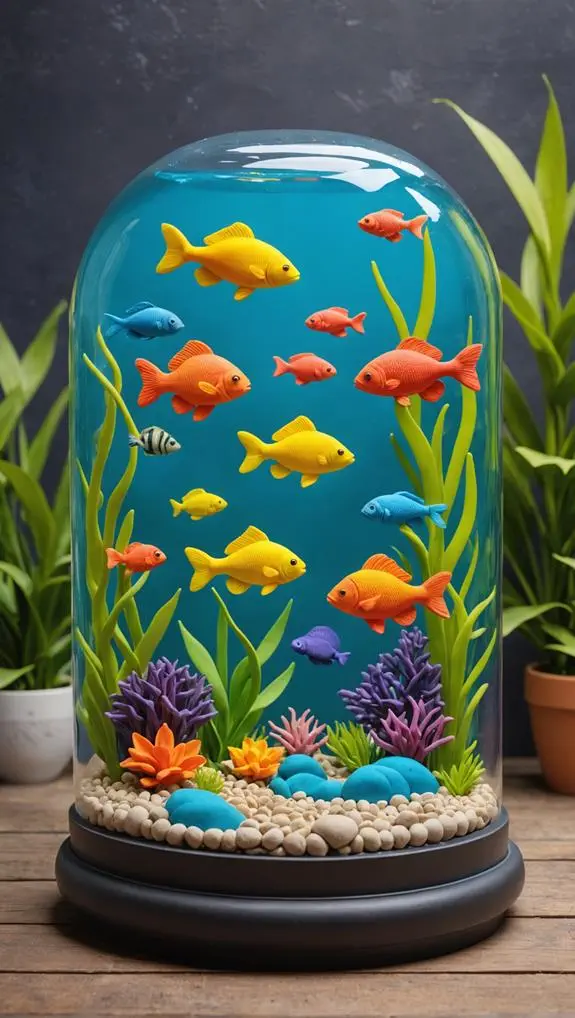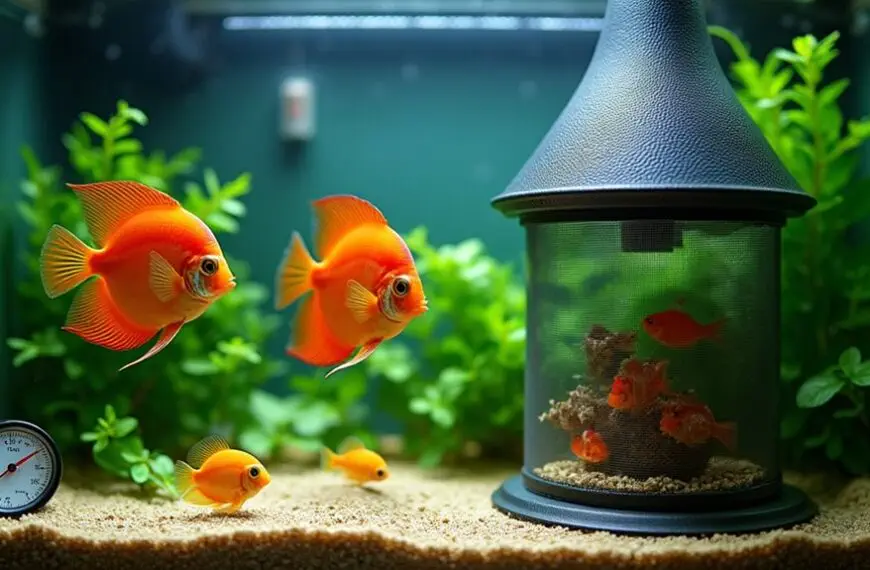When you're breeding freshwater fish, feeding them properly is crucial for their health and growth. Start by giving freshly hatched fry infusoria or powdered fry food for essential nutrients. Make sure to feed them small portions several times a day—aim for about six to prevent them from going hungry! It's also vital to avoid overfeeding, which can lead to water quality issues and sick fish. Mix things up with live foods and carefully observe their behavior and growth. Trust me, healthy, happy fish are more likely to breed. Keep going to discover more tips that can help you succeed!
Contents
- 1 Importance of Proper Feeding
- 2 Nutritional Needs of Fry
- 3 Types of Foods for Fry
- 4 Feeding Frequency and Portions
- 5 Transitioning to Solid Foods
- 6 Monitoring Fry Health
- 7 Avoiding Overfeeding Issues
- 8 Enhancing Growth With Varied Diets
- 9 Special Considerations for Different Species
- 10 Frequently Asked Questions
- 11 Final Thoughts
Importance of Proper Feeding
How crucial is proper feeding for your freshwater fish? It's essential! The importance of proper feeding can't be overstated, especially when it comes to your fish and fry. Newly hatched fry depend on small meals packed with nutrients, like infusoria and powdered fry food, to grow strong and healthy. You'll want to feed them several times a day to ensure they get everything they need.
Additionally, ensuring the right diet tailored to specific species, such as schooling behavior for tetras and rasboras, can significantly enhance their growth and overall well-being. Feeding frequencies usually range from 1 to 3 times daily, depending on your fish's species and life stage.
Remember, though, that overfeeding can lead to serious problems like Swim Bladder Disease and can mess up your water quality. A good rule of thumb is to serve portions your fish can eat in about 2-3 minutes.
Mixing up their diet with high-quality flakes, pellets, and the occasional treat of live or frozen foods keeps things interesting and boosts their immune health.
And when introducing new fish, be mindful of their feeding habits to prevent stress and competition at mealtime. After all, a well-fed fish is a happy fish! So, take the time to get it right, and your aquatic friends will thrive.
Nutritional Needs of Fry
After ensuring your adult fish are well-fed, it's time to focus on the nutritional needs of fry. These tiny fish are just starting their journey, and you want to give them the best start possible.
In their first few days, fry rely on their yolk sacs for nourishment. Once they're strong enough to swim, you'll need to feed the fry frequently—at least six times a day with small portions. This helps them avoid starvation and supports their rapid growth.
Maintaining optimal water parameters, such as a stable pH and low ammonia levels, is also critical for fry health, as proper water conditions significantly influence their development.
A fantastic first food for fry is infusoria, a rich micro-organism that you can easily create by letting lettuce leaves decompose in the spawning tank.
As your fry grow, you can introduce powdered foods or even hardboiled egg yolk paste to mix things up a bit.
For larger fry, live baby brine shrimp are like the gourmet meal of the fish world! Not only do they pack a nutritional punch, but they also encourage natural hunting behavior.
Types of Foods for Fry

When feeding fry, you'll often find that their dietary needs change rapidly as they grow. In the early days, newly hatched fry rely on infusoria, tiny organisms you can cultivate by letting some lettuce leaves decompose in their tank. This provides essential nutrients and helps them thrive.
After a week, it's time to introduce powdered foods, which offer balanced nutrition and ease their transition to larger food options.
As your fry continue to grow, hardboiled egg yolk paste becomes a fantastic addition to their menu, boasting high protein content that's crucial for their development. If you want to really treat them, live baby brine shrimp are a top choice. Not only do they enhance growth rates, but they also spark those natural hunting instincts that fry love to explore!
For optimal health, remember to serve small portions multiple times a day, ideally 3-5 times. This keeps your fry well-fed and ensures they receive consistent nutrients.
Feeding Frequency and Portions
Feeding frequency and portion sizes play a crucial role in the health and growth of your freshwater fish. You'll want to feed your fish 1-3 times a day, but remember, each species has its own needs. Young fish and fry require a bit more love, so aim for 5-6 feedings daily, as they're like teenagers—always hungry!
To maintain a peaceful community, it's essential to monitor how different species interact during feeding time, as some may be more aggressive in competing for food maintaining tank harmony.
When it comes to portion sizes, keep it simple: offer only what they can gobble up in about 2-3 minutes. This helps prevent overfeeding and keeps your tank from turning into a murky mess. No one likes a messy home, right?
Observe your fish carefully for hunger cues. If they seem eager, it might be time to increase the frequency or portion sizes. Don't forget to adjust as needed when introducing new species or changing up the tank dynamics.
You're not just feeding fish; you're nurturing their growth and ensuring they thrive. With the right feeding frequency and portions, you'll watch them flourish and bring joy to your aquatic world.
Transitioning to Solid Foods

As your fry grow and become more active, it's time to introduce solid foods into their diet. You'll want to start this transition once they've absorbed their yolk sacs, usually around 1-2 weeks old.
Begin with small amounts of high-quality powdered foods or crushed flakes to make it easier for them to eat.
Don't rush things! Gradually increase the portion size as they grow and can handle larger pieces.
Variety is key, so consider adding live baby brine shrimp or micro-worms to provide a balanced diet that promotes optimal growth. Your fry will appreciate the change, and you'll feel good knowing you're nurturing them right.
While feeding, keep an eye on their behavior; if you notice some fry aren't eating, it might be time to adjust the food size or type.
This monitoring consumption is crucial to ensure every little fish gets its fill.
Monitoring Fry Health
Keeping an eye on your fry's health is super important, so let's chat about what to look for.
You'll want to spot signs like energetic swimming and vibrant colors, which show they're thriving, while sluggishness or dull hues could be a red flag.
Plus, feeding them right and watching for any weird behaviors can help you catch issues before they turn into big problems—because nobody wants a fry party turned health crisis, right?
Signs of Healthy Fry
Regularly monitoring the health of your fry is essential for successful breeding. You want your little fish to thrive, and spotting signs of good health can make all the difference.
First, keep an eye on their swimming patterns. Healthy fry should swim with energy, exploring their environment like tiny adventurers. If they're actively feeding and showing excitement during mealtime, that's a great sign—they're well-nourished and not facing any health concerns.
Next, look at their coloration. Vibrant colors mean your fry are lively and healthy. If they start to look dull, it might indicate stress or illness, which is never fun.
Also, check their eyes! Clear, unclouded eyes are a must. Cloudiness could suggest infections or other issues that need addressing.
Lastly, monitor their growth. Healthy fry should be growing at a consistent rate for their species. If you notice any slowpokes, it's worth investigating the water conditions or their feeding habits.
Common Fry Health Issues
Monitoring the health of your fry is crucial, and being aware of common health issues can save you a lot of trouble down the line. Regular observation is key; if you notice your fry swimming strangely or being unusually lethargic, it might be a sign of distress.
This is where water quality testing comes into play—keeping an eye on ammonia, nitrite, and nitrate levels ensures your fry grow strong and healthy.
Don't forget about proper nutrition! A varied diet, including infusoria and specialized fry food, not only supports healthy growth but also boosts their immune systems.
Early signs of illness, like white spots or cotton-like growths, can indicate infections that need immediate attention.
If you spot any deformed or weaker fry, consider culling them. This might sound harsh, but it's essential to maintain the overall health of the group and prevent stress from spreading.
Optimal Feeding Practices
Fry health hinges on optimal feeding practices, which play a vital role in their growth and development.
To keep your little swimmers thriving, it's essential to monitor their activity levels. Healthy fry are active and curious, exploring their small tanks as they search for food.
Make sure you're checking water quality regularly, too. Ammonia and nitrate levels can sneak up and stress out your fry, leading to health issues. You wouldn't want to live in a messy environment, right?
When it comes to feeding, it's best to offer small portions multiple times a day—aim for about 3 to 6 times. This approach supports their rapid growth while ensuring they get the nutrition they need without overloading their tiny systems. Live foods like baby brine shrimp or infusoria are fantastic choices, providing essential proteins and encouraging those natural hunting instincts.
Lastly, remember to space out your fry appropriately in their tanks. Too many fry in one place can lead to competition for food and increased stress.
Avoiding Overfeeding Issues

When it comes to feeding your fish, it's easy to go overboard—literally!
You'll want to watch for signs like lethargy or bloating, which can mean your fish are feeling a bit too full.
Recognizing Overfeeding Symptoms
Overfeeding your fish can lead to serious health issues, so it's crucial to recognize the signs early. If you notice your fish with visibly swollen abdomens or acting lethargic, these might be overfeeding symptoms. You could also see them floating oddly, which can signal swim bladder disease.
Keep an eye on uneaten food, as it can pile up and contribute to poor water quality. Stale remnants can raise ammonia levels, making your fish's home less hospitable.
Another sign to watch for is when you see fish exhibiting aggressive scratching against surfaces. This behavior often means they're struggling with digestive distress, possibly from too much food. If you're doing frequent water changes and your tests show elevated nitrate levels, it might be time for dietary adjustments.
When you feed your fish, pay attention to how much they actually eat. If they leave food uneaten after a few minutes, it's a good idea to reduce those portion sizes.
Your fish depend on you to keep them healthy and happy, so recognizing these signs can help you provide the best care possible. After all, a well-fed fish is a happy fish!
Proper Feeding Portions
To maintain a healthy aquarium, it's important to serve your fish the right feeding portions. Think of it as preparing a lovely meal for friends; you want everyone to enjoy it without overindulging.
For most fish species, aim to feed them portions they can consume within 2 to 3 minutes. This helps prevent overfeeding, which can lead to messy water and unhappy fish.
If you've got small fish, they might need up to three meals a day, while larger or lazier species are perfectly fine with one or two.
Keep an eye on your fish after feeding—if there's uneaten food lingering on the bottom, it's time to cut back a bit. Using high-quality food is essential too; it gives your fish the nutrition they need without adding unnecessary bulk.
Regularly check how your fish look. If they seem bloated or struggle to swim, you might need to adjust their diet.
Feeding Frequency Guidelines
Finding the right feeding frequency for your fish is crucial in maintaining their health and happiness.
You want to avoid the pitfalls of overfeeding, which can lead to serious issues like fungal infections or Swim Bladder Disease.
So, let's dive into some feeding frequency guidelines that can help you provide good care for both adult and baby fish:
- Feed adult fish 1-2 times daily: This amount keeps their bellies happy without risking overfeeding.
- Feed baby fish 3 times daily: They need that extra nourishment for growth, but keep portions small!
- Limit each feeding to 2-3 minutes: Watch them gobble it up; if there's leftover food, adjust the portion next time.
- Observe for hunger cues: If your fish start doing the hungry dance, you might need to tweak their schedule.
Enhancing Growth With Varied Diets
When aiming to enhance the growth of your freshwater fish, offering a varied diet is crucial. Just like us, fish thrive on diversity in their meals! Start with high-quality flakes or pellets as a staple, but don't stop there. Incorporating live foods, like daphnia or brine shrimp, can work wonders for those tiny fry.
They need small amounts of food several times a day, so think infusoria or specially formulated fry powders to meet their tiny appetites.
Don't forget about the high-protein options! Finely chopped frozen foods or baby brine shrimp can really boost growth rates and improve overall health.
And if you're feeding predator fish, gut-load your feeder fish with nutritious goodies first; it's a game-changer for their health.
Regularly varying their diet not only enriches their nutrient intake but also triggers natural hunting behavior. That's right! Your fish will feel like little champions, which helps manage stress and keeps them happy.
Special Considerations for Different Species

Different species of freshwater fish have unique dietary needs that can significantly impact their growth, health, and breeding success.
By understanding these needs, you can better care for your breeding pairs and ensure their happiness.
Here's a quick guide to help you out:
1. Guppies love high-protein foods like live brine shrimp.
Feed them multiple times a day to keep their metabolism happy.
2. Cichlids, like Convict cichlids, enjoy a varied diet including spirulina and pellets.
This boosts their color and helps them thrive during fish breeding.
3. Betta fish need a protein-packed diet with live or frozen treats like bloodworms.
This gives them the energy to put on a show during breeding!
4. Discus fish require high-quality granular or frozen foods that contain animal protein for their growth and breeding success.
Frequently Asked Questions
What Is the Best Food for Breeding Fish?
For breeding fish, focus on high-protein sources like live foods to meet their protein requirements. Maintain a frequent feeding schedule, ensuring optimal fry nutrition while observing their feeding behavior to promote healthy spawning and growth.
How to Encourage Fish to Breed?
To ignite the spark of life in your aquatic realm, adjust the water temperature, fine-tune the tank environment, observe the male-female ratio, and introduce suitable tank mates that stimulate spawning triggers and encourage vibrant breeding behavior.
What Are the Guidelines for Feeding Fish?
Establish a fish feeding schedule tailored to each species' nutritional requirements. Choose appropriate types of fish food to match their feeding behaviors. Avoid common feeding mistakes to maintain water quality and ensure your fish thrive.
What Is the Easiest Fish to Breed for Feeders?
If you're looking to breed fish for feeders, guppies are your best bet. Their guppy breeding is straightforward, and with proper water quality and care, you'll enjoy a steady supply of fish fry.
Final Thoughts
Feeding your fry isn't just about keeping them full; it's about nurturing their growth into vibrant, healthy fish. Picture them darting around your tank, full of life because of the care you've given them. By following these tips and paying attention to their needs, you're setting the stage for a flourishing underwater community. So, get ready to watch your little swimmers thrive! Just remember, a well-fed fish is a happy fish—who knew fish could have such big personalities?












